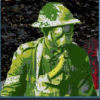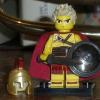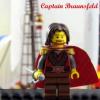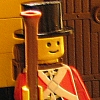Search the Community
Showing results for tags 'cannons'.
Found 7 results
-
A Napoleonic inspired Ship of the Line for glorious Oleon. Heavily inspired by Wellesly's HMS Persephone and Invicta's hull/tumblhome technique on YouTube. She has 84 guns and three decks. 36-pounder guns on the lowest deck, 24-pounder everywhere else. The galley and chimney.
- 12 replies
-
- oleon
- shipoftheline
-
(and 2 more)
Tagged with:
-
Hello fellow builders, I present you the Flying Dutchman, the infamous ghost ship from the Pirates of the Caribbean film series, in LEGO! The idea came to me a year ago, while I was sitting at my desk when I cast me eyes upon the 3 official LEGO POTC ships on the top of my shelf: The Black Pearl, The Queen Anne's Revenge, and The Silent Mary. For years I had been waiting for LEGO to release a Flying Dutchman, but to no avail it never came out. Determined to build the ship myself, I embarked on an exciting, challenging but rewarding journey to produce a MOC which would take up its rightful place among my fleet and make it complete. More information can be found here at LEGO IDEAS. If you like it, feel free to support! Here are some renders below (more can be found on my Flickr page): LEGO Flying Dutchman - 1 by Scarvia LEGO Flying Dutchman - 2 by Scarvia LEGO Flying Dutchman - 4 by Scarvia And with the crew: LEGO Flying Dutchman - 6 by Scarvia The infamous triple-barrelled chasers in the bow: Triple-barrelled chasers (Out) by Scarvia Triple-barrelled chasers (In) by Scarvia Thank you for your time.
-
Location: Mesabi Landing Type: Medium Factory With the Count Away on some half baked adventure, it was up to Agnes to keep the peace in Mesabi Landing. Today, she toured the New Cannon Foundry. The Foundry by North White, on Flickr "So, give me a tour of this place." She said unhappily. It was hot outside, and hotter in the Foundry. "Yes of course, countess." Said the foreman, John Slader. The Foundry by North White, on Flickr "First, we make a mold of a cannon with a sand clay mixture. We usually use a MAESTRO cannon for the mold, and engrave 'WTC' On it." Said John "Good to hear you're using the WTC's business model." Replied Agnes. The Foundry by North White, on Flickr "Next, we burn wood to melt the iron." The Foundry by North White, on Flickr "We melt down iron for the cannons. Usually we use iron pellets, but any old iron will work." The Foundry by North White, on Flickr "The melted iron is poured into the mould, which is mounted on these rails." The Foundry by North White, on Flickr "We move the mold out of the the way, and let it cool." The Foundry by North White, on Flickr "Once the mould has cooled, we remove it from the cart, and take it outside. Afterwards, another mould is attached to the cart, and iron poured in." The Foundry by North White, on Flickr "The Cannon is chipped out of the mould." The Foundry by North White, on Flickr "Finally, the Cannon is mounted, and it is slowly turned into a chisel, hollowing out the inside. Once that's finished, it's brought to another factory for the mounting." The Foundry by North White, on Flickr "Impressive set up!" Said Agnes, unusually impressed. "Thank you!" Said John. FIN Thanks for viewing my build for a factory in Mesabi Landing! I took everything from a "How it's made" video. It is a medium build, it might not look it, but it has 1024 studs total, which equals 32x32. C&C appreciated!
-
So, I'm trying to design a fort. This is a quick idea that I had that I think would look cool. I'm not going for historical accuracy, I just want to build something that looks good. Eventually I'll try to build it in real bricks (working on a base right now). So, what do you think? How can/should I make the wall more interesting? Has anyone done something like this before? I'd be happy if you'd link me some cool fort builds, and real forts for inspiration. I've been searching on google, but I haven't actually found much.
-
166C Ahoy, today it is my great pleasure to present to you something I find nice and funny: The HMS Royal Monkey. It looks like a normal vessel. but if you take a close look, you will find signs of monkey-driven-design And you will find a few guests that have joined Captain Braunsfeld on his journey. Kurigan, sorry, I don't have the exact torso... The key point, however, is the Royal Monkey himself: :pir_laugh2: (Those of you more interested in historical accurateness might want to look at the lanterns instead. And the rudder is actually working!!!) I had a lot of fun building this. I hope you will be able to enjoy it too! By the way, it takes an awful lot of bricks to build a lego-sky-background... :pir-grin: :pir-grin: I am looking forward to your feedback!
-
Expensive and history and even more expensive in Lego, I am finding it very hard to find cheap cannons. I have scoured Bricklink and came up with nothing. Why are they so expensive? I got 3 mid-sections, 2 end-sections and a bow off bricklink for less than £4 so why are cannons like £2 each? I am building my first ever sailing ship and only a few (around 10) cannons would do and I am simply no willing to break the bank on them. Thanks, Spud.
-
[pid][/pid] This tutorial has been sitting on my computer for ages and I only now decided to finish it and along with another project, end my micro-dark age. It’s about a piece of equipment almost as important as the ship itself: the European cannon. Please notice that while I do know a good deal about Asian Cannon and early Asian rockets I will not cover them in this tutorial! PART I – basics, material and history Cannon (from lat. Canna - “reed”) are projectile-launching weapons that were first used in the Far East and came into use in Europe during the High Middle Ages. It was the first gunpowder weapon on battlefields to be used at a large scale with effectiveness above that of a psychological impact. Although Cannon greatly varied over time and purpose in shape, composition, material, carriage and performance they still shared very distinctive features over hundreds of years. Cannon are always tubes made of metal that are mounted on a carriage (“Lafette”) and are almost always loaded via the muzzle. A gunpowder charge will be embedded between the thickest part of the cannon (the reinforce) and a cannonball. It is ignited by a fuse or a mechanism that is accessible via a small vent. The standard projectiles of cannon first were made out of stone, later metal. It quickly became common to classify cannon according to the type of projectile they could fire rather than the appearance of the actual cannon itself. A 12 pounder (a cannon capable of firing cannonballs that weighed 12 pounds) could look completely different in comparison to another 12 pounder just because one of them was being used on a ship and the other one on the field. Cannon came into use in Europe around the late 13th and early 14th century. The first major war to feature effective Cannon made of iron was the Hundred Year War. Most cannon, however, were being made from bronze at the time as this was a much more durable and reliable metal. With the propagation of improved cast iron (especially in England) in the late 15th century the European cannon got yet another material improvement and by the late 18th century almost all cannon were made from cast iron. European vessels were being equipped with cannon from at least 1330. However, designated battleships with sails came not into use until the early 16th century when the English Navy started constructing men-of-war specifically built for carrying large amounts of cannon. The first recorded purposely built gun deck was built around 1500. Until this time it was much more common to refit merchant ships like carracks, cogs, galleys and caravels into war ships if the need arose. Around the middle of the 16th century most European armies began standardizing their cannon size according to the aforementioned weight of the projectiles. Improvements in the gunpowder used and the quality of the structure of the bore allowed for smaller cannon that were actually mobile and allowed for much quicker advancing armies that could still fire over great distances. This development of siege possibilities also greatly changed the methods employed to construct fortifications (see the development of fortifications in this tutorial). While details such as transportation (limbers), aiming (trunnions) or better projectiles (cast iron projectiles) continued to increase the effectiveness of cannon they remained largely the same during the next few hundred years with the only notable exception being the mortar – a cannon designed to fire projectiles over large distances and send them across fortifications. Major change to the cannon was brought by the massive development of men-of-war in the 18th and the 19th century. The introduction of the carronade in the late 18th century supported quicker and more manoeuvrable ships: smaller, lighter Cannon being able to deliver 32 pound ordnance on short range that was able to virtually pulverize the hull of an enemy ship. Gunlocks drastically improved the speed, safety and accuracy of quickly loaded, hot cannon. In addition to improved accuracy and firing rates, new ordnance types (shrapnel shots and reliable explosive shots) brought new elements into field- and sea battle. The introduction of steel-Cannon in the mid-19th century made way for the demise of the classic cannon: although still being used until the early 20th century the cannon would eventually be replaced by steel-made field artillery and recoilless guns. PART II types and calibres This part of the tutorial will focus on cannon that were in use after the ordnance classification system had been well established. While a lot of basic cannon types will be described keep in mind that there have been well over 70 types of cannon in Europe alone and hundreds of specialized cannon series. Sakers - 4–7 pounders Sakers were relatively light cannon used en masse during the 16th century. Made from bronze they were designed for long range attacks against moving armies or fortifications. The early models still used stone ammunition but all later versions used the more modern iron ammunition. Sakers were very heavy and relied on a stable and heavy carriage due to the immense recoil the large gunpowder charge caused – thus they were used from fixed positions and were not moved during a battle. Culverins – 14-20 pounders Also used on sailing ships (merchant ships, men of war) Culverins were used from the middle to late 15th century until the early 17th century. They were made from bronze and featured a very long and thin bore (up to 5 meters) that could fire very different types of cannon balls. It was one of the first cannon to be successfully mass-produced and was able to fire cannon balls made from iron. A culverin was operated by between three and five gunners and was normally being transported on the mobile carriage with or without a limber. Mortars – 82 – 180 pounders Also used on sailing ships (bomb ketches) Mortars were used from the middle 15h century till the end of cannon. They featured a very short and large bore that looked more like a bowl than a barrel. Mortars had a high trajectory allowing for large range and the possibility to attack an enemy behind a fortification. The low velocity of the projectile also allowed for explosive rounds to be used. A mortar could be operated by two to four gunners and was very immobile due to the immense weight of cannon and ammunition. Full cannon – 42 pounders Also used on sailing ships (ships of the line) Full cannon were used during the 17th century and were normally made from cast iron. If they were to be used on a ship the preferred material was bronze in order to keep the weight lower. They were designed to take down heavy fortifications and to engage slowly moving targets at long range. On ships they were used on the top battery deck as the back bone of close range broadside attacks. Full cannon were immobile on the field and considered to be impractical due to large gunner crews of 5 to 9. Demi cannon – 32 pounders Also used on sailing ships (ships of the line, frigates) Demi cannon were used in the 17th century as a semi-accurate and close range cannon that was usually made from cast iron. The cannon required a gunner crew of at least 4 persons and would normally be used to attack advancing armies with regular shots and grapeshot attacks. Demi cannon were largely immobile due to their weight. Minions – 5 pounders Also used on sailing ships (all types of ships) Minions were the weapon of choice for close range anti-personnel attacks in the field and on ships. The small cannon was used from the 15th century till the early 18th century and could be seen as a “big brother” of the swivel gun. Minions could be carried by mobile carriage or by the gunner crew that could be 1 to 3 people. Minions were considered to be highly mobile weapons that could easily be used to defend advancing points during a battle. Howitzer cannon – 12-24 pounders Howitzers were a hybrid between regular cannon and mortars, being used from the late 17th century till the end of the age of sail. The Howitzer was mobile and could be quickly adjusted to various angles, making it a somewhat inaccurate but fast and flexible siege weapon. The Howitzer could fire a great variety of different ammunition, making it efficient in use against fortifications and army formations. A Howitzer was being operated by a gunner crew of three to 6 persons, depending on the size and the purpose of the Howitzer. Howitzers were mobile but larger versions could be difficult to move during a battle. Carronade – 6-42 pounders Mainly used on sailing ships (all types of men of war) The carronade was an immensely popular naval cannon presenting the complete range of cannon sizes. A short bore and a smaller charge chamber would fire a low velocity cannon ball with a short effective range. The low speed would damage the hull of the enemy and the deck behind it much more than high velocity ammunition. The carronade was being used from the late 18th to the late 19th century. While the short range did only allow for passing fights the high speed of the reloading process, the devastating damage and the small amount of gunners (2 to three) needed made it a perfect cannon for fast ships or ships of the line. PART III carriages, casemates and additional equipment As diverse as the cannon types were as diverse was the equipment used with them. Carriages featured large or small wheels, four or two wheels and very often no wheels at all. They would normally be transported with or on limbers that was also used to carry ammunition, cleaning equipment, aiming aids and so on. A single Culverin with equipment could need up to 4 horses to be transported. Many cannon featured different styles of trunnions that could be used to change the firing angle by adjusting the height of the muzzle. Cannon were also used in fortifications. They were often positioned on the top or within casemates. These cannon could feature very innovative carriages that were designed specifically to be able to quickly adjust the firing angle in order to compensate for the inability to move the cannon. Thank you for reading all the way down here! No go enjoy the lxf-file on cannon in LDD!





